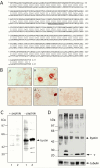The Bysl gene product, bystin, is essential for survival of mouse embryos
- PMID: 17055491
- PMCID: PMC1764500
- DOI: 10.1016/j.febslet.2006.09.072
The Bysl gene product, bystin, is essential for survival of mouse embryos
Abstract
Human bystin is a cytoplasmic protein directly binding to trophinin, a cell adhesion molecule potentially involved in human embryo implantation. The present study shows that bystin is expressed in luminal and glandular epithelia in the mouse uterus at peri-implantation stages. In fertilized embryos, bystin was not seen until blastocyst stage. Bystin expression started during hatching and increased in expanded blastocyst. However, bystin apparently disappeared from the blastocyst during implantation. After implantation bystin re-appeared in the epiblast. Targeted disruption of the mouse bystin gene, Bysl, resulted in embryonic lethality shortly after implantation, indicating that bystin is essential for survival of mouse embryos.
Figures




References
-
- Suzuki N, Zara J, Sato T, Ong E, Bakhiet N, Oshima RG, Watson KL, Fukuda MN. A novel cytoplasmic protein, bystin, interacts with trophinin, tastin and cytokeratin, and may be involved in trophinin mediated cell adhesion between trophoblast and endometrial epithelial cells. Proc. Natl. Acad. Sci. USA. 1998;95:5027–5032. - PMC - PubMed
-
- Fukuda MN, Sato T, Nakayama J, Klier G, Mikami M, Aoki D, Nozawa S. Trophinin and tastin, a novel cell adhesion molecule complex with potential involvement in embryo implantation. Genes Dev. 1995;9:1199–1210. - PubMed
-
- Fukuda MN, Nozawa S. Trophinin, tastin, and bystin: a complex mediating unique attachment between trophoblastic and endometrial epithelial cells at their respective apical cell membranes. Sem. Reprod. Endocrinol. 1999;17:229–34. - PubMed
-
- Suzuki N, Nakayama J, Shih IM, Aoki D, Nozawa S, Fukuda MN. Expression of trophinin, tastin, and bystin by trophoblast and endometrial cells in human placenta. Biol. Reprod. 1999;60:621–7. - PubMed
Publication types
MeSH terms
Substances
Grants and funding
LinkOut - more resources
Full Text Sources
Other Literature Sources
Molecular Biology Databases

